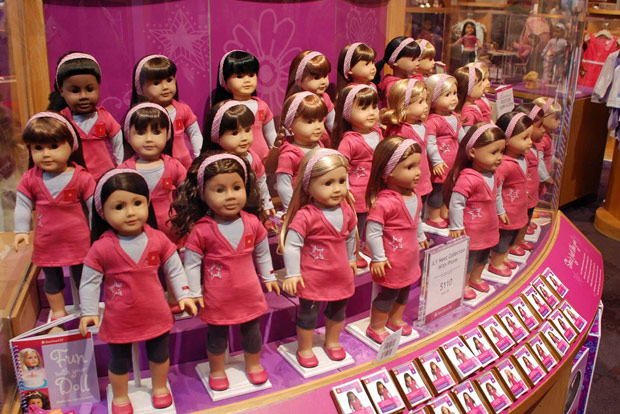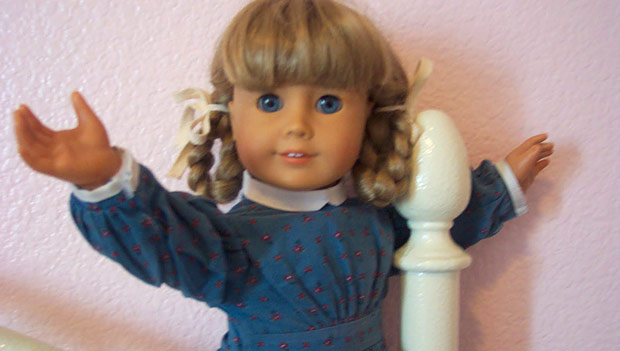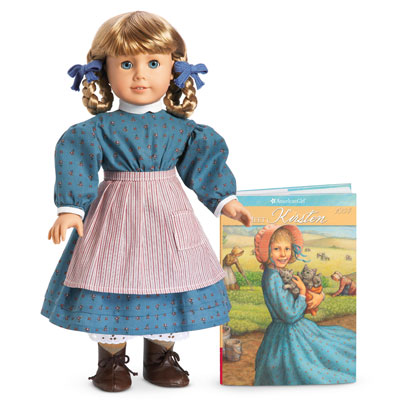
I was not girly growing up, and could probably count the total numbers of dolls I ever owned on one hand, but I have never wanted anything more for Christmas than I wanted an American Girl doll in 1997. It was an infatuation. I knew the catalog front to back: there are some spreads I can recall from memory even now, 14 years later (Molly’s school set! Kirsten’s Christmas kit!). Back then — operating as “Pleasant Company Inc.” — American Girl Inc. sold five models of these historical dolls in the late ’90s, three of which were originals that had been around since the company’s inception in 1986: Felicity, Kirsten, Addy, Samantha, and Molly. Each girl possessed her own set of honorable “American” traits, and each came from an exciting, romantic period of American history.
Related Posts

In 1998 the company also sold “My American Girls,” modern-day dolls that resembled you, but I didn’t know a single girl in the third grade who decided to go for a doll without a backstory. In the ’90s there was a genre of historical fiction for kids dedicated to the pioneers who traveled West in the 1800s (true story, look it up), and I was obsessed with it. There was something epic about moving across the entire country at a glacial pace that thrilled me, I guess. Kirsten Larson, this 10-year-old girl whose Swedish family settled in Minnesota in the 1850s, the star of the Meet Kirsten books, was “my American girl” from the beginning.
I keep saying “girl” and not “doll” because these were not the kind of dolls intended to instill in girls some sort of maternal trait. Each American Girl had her own book series, with titles like Meet X, X and The Holiday She Celebrates, X Faces a Big Life Thing, etc. In order to appreciate the dolls, you needed to have read the books: the dolls are essentially statues — not just of their characters, but of the whole era their characters represent. So when Christmas ’97 came around, I had read all of Kirsten’s books and knew her whole story, and so I needed the Kirsten doll to seal the deal, to make her character (and all of the pioneers involved in the crossing) tangible and real.
 Sure enough, when Christmas morning came I opened a box with Kirsten (“a brave, steadfast girl of the Frontier,” according to the catalogue) inside. There she was, in the (plastic) flesh, dressed in her petticoat and her blue apron, her shiny blonde hair styled in looped-up braids. For my sister, my parents chose Felicity, whose resume listed adjectives like “spunky,” “brave,” and “independent-minded.” Felicity represented the Revolutionary War era.
Sure enough, when Christmas morning came I opened a box with Kirsten (“a brave, steadfast girl of the Frontier,” according to the catalogue) inside. There she was, in the (plastic) flesh, dressed in her petticoat and her blue apron, her shiny blonde hair styled in looped-up braids. For my sister, my parents chose Felicity, whose resume listed adjectives like “spunky,” “brave,” and “independent-minded.” Felicity represented the Revolutionary War era.
That is what these dolls did well: represented, and introduced girls to, history. My sister, who never read books, slowly developed an interest in this period of American history, brought on by a curiosity of Felicity’s life. She too wanted to be familiar with the era in which Felicity lived. To keep up with my sister I had to cultivate an interest in Colonial America as well, so that year, to quench our sudden fascination, my parents took us to Old Williamsburg for a long weekend (Minnesota was too far away, not enough of a tourist spot). Clari brought Felicity, and I brought Kirsten along for the ride. After all, it was their country’s history, too.
Today, when you go to American Girl Inc.’s website, their mission statement states that “American Girl [dolls] show girls of today that they can do great things if they believe in themselves and each other.” There is no history aspect mentioned. The company’s PR changed its tune after receiving a lot of criticism in the ’90s by feminist groups who claimed that, by selling dolls in dresses, the company was doing nothing to actually empower young females. It isn’t the same anymore, but in 1997 when I scoured their catalogues, every single doll you could order came clad in a pretty dress.
In response, the company published a line of self-help books, in which the company taught American girls about hygiene, ettiquete, and how to deal with every kind of feeling. American Girls, Inc. began to focus more on making sure their company was empowering girls socially, rather than focusing on the education through which girls could also feel empowered.
Related Posts
 The flagship American Girl Store opened in Chicago in 1998. Before that, dolls were mailorder only. In Chicago for the first time over New Years, I went, not the least bit ironically, to check the place out. The store is awesome: huge, colorful, and way better than the Barbie house in the Toys “R” Us Union Square. But I was almost immediately bummed out when I noticed the majority of my fellow morning shoppers were young girls huddled around the “My American Girl” kiosk, where they were all browsing for dolls that resembled themselves.
The flagship American Girl Store opened in Chicago in 1998. Before that, dolls were mailorder only. In Chicago for the first time over New Years, I went, not the least bit ironically, to check the place out. The store is awesome: huge, colorful, and way better than the Barbie house in the Toys “R” Us Union Square. But I was almost immediately bummed out when I noticed the majority of my fellow morning shoppers were young girls huddled around the “My American Girl” kiosk, where they were all browsing for dolls that resembled themselves.
“But I need a green eyed one! And it needs to have brown curly hair,” I heard a girl who looked to be about 11 explaining anxiously to her mom. “They only have green eyes and straight. And it comes with a journal, yeah?”
I must have looked totally depressed by what I was eavesdropping, because that’s about the time when the sales associate approached me.
“Are you having any trouble? You’re gonna have to wait in line to order one of these,” I was told as she motioned towards the My American Girl kiosk we stood near. “But if you want one of those historical ones over there, it isn’t much of a wait.”
“Are people just, like, not into them anymore? Like Kirsten and them?” I asked, almost wanting to cry.
The saleswoman raised an eyebrow at me. She wasn’t very sweet. “Rarely, a lot of collectors though. ‘Old’ isn’t ‘cool’ anymore. You think these girls give a crap about the old girls?”
Something came to mind to say something about history not being old, and history being more of a perpetual thing you can still learn from, and that history, like stories, cannot get old. But the sales associate totally didn’t care — she was just here to sell this shit, so I kept my mouth shut.
Related Posts
It’s 2012 and all those girls have YouTube accounts where they record themselves talking and I should have known. American Girl History is dead.
—
Christina Drill is from Fair Lawn, New Jersey and currently writes and teaches in Panama City, Panama. Follow her on Twitter! (@stidrill.)